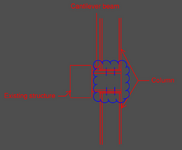Hi all,
I have a column attaching between two short cantilevered beams and it has been modelled with pinned end connections. Therefore, the connections are only subject to axial and shear loads. When performing detailing checks on this connection, would you recommend following the design example for bolted end plate connections under axial and shear loading (where the column is basically the beam member in the example - AISC Companion Vol. 15 Ex. II.A-11B)?

I have a column attaching between two short cantilevered beams and it has been modelled with pinned end connections. Therefore, the connections are only subject to axial and shear loads. When performing detailing checks on this connection, would you recommend following the design example for bolted end plate connections under axial and shear loading (where the column is basically the beam member in the example - AISC Companion Vol. 15 Ex. II.A-11B)?

